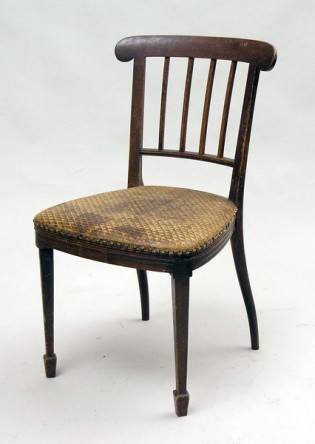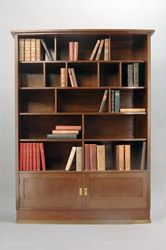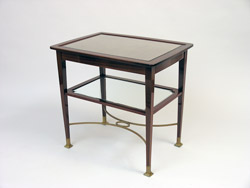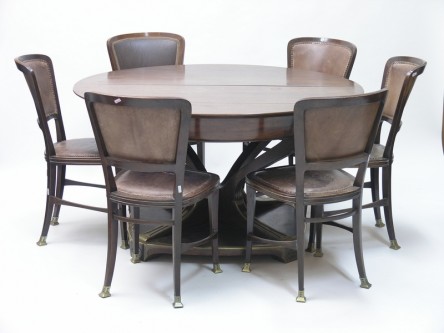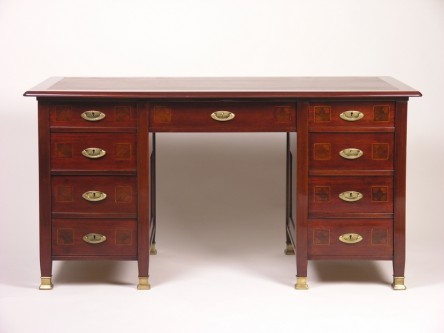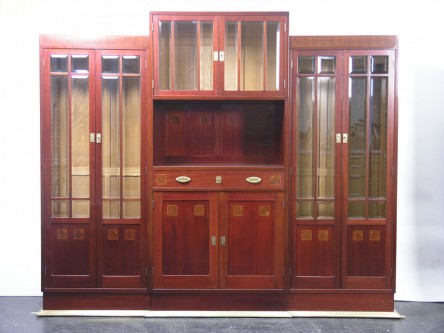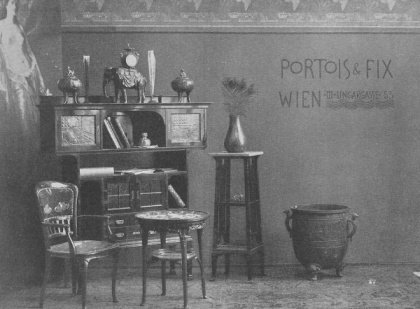
Portois & Fix
Portois & Fix was founded in 1881, when the decorators Anton Fix (1846 - 1918) and August Portois (1841-1895) joined forces.
Anton Fix was an upholsterer who had taken over his father’s company in 1872. One year later, in 1873, he was awarded the Silver Medal and the Golden Cross of Merit for his performance at the Vienna World Fair.
August Portois, born in Brussels in 1841, was partner in a trading company in Paris and had been running a company with its own manufacturing workshop in Vienna since the 1870s.
Registered as “Portois & Fix” in 1881, the company specialised in trading with furniture, wall coverings, marble fireplaces and decoration elements. The official registration for the manufacturing of furniture, however, took place only in 1884.
Already in 1892, August Portois left the company and Anton Fix continued to run the business as sole owner under the name “Portois & Fix” until 1907, when it was transformed into a joint-stock company operating under the same name.
The company received commissions for the furnishing of private and imperial interiors, the furnishing of business premises, such as Demel Confectionery in 1888, but also of hotels, ships, etc.

In 1899, the architect Max Fabiani designed a modern business and residential building for Portois & Fix at Nos. 59-61 Ungargasse in Vienna’s third district. The multi-storey building with apartments and workshops became a landmark in Vienna. The company accommodated a joinery with several hundred workers, a gilding facility, an upholstery and a sewing workshop.
Around 1900, the Viennese company experienced a period of prosperity. Max Fabiani did not only build the large company building, he also designed the entire reception room of the Austrian pavilion at the Paris World Fair in 1900.
In the new business premises at first furniture of different styles was offered for sale in a “spirited, comfortable composition”: “The rooms of the first floor were furnished in a sequel of different styles: Empire, Louis XVI, Louis XIV, then English, then modern, i.e. furnished with furniture, bronze figures, faiences, etc. of these styles”. In addition, there were two floors with everyday furniture and separate storage furniture.
At the beginning of the 20th century, the product range was particularly diverse: in addition to manufacturing period furniture, Anton Fix and his son Robert were already looking into contemporary trends.
The designs of Anton Fix and his son but also collaboration with different architects, who had their designs manufactured by Portois & Fix or were commissioned by Portois & Fix, resulted in pioneering furniture and interiors.
Famous examples include furniture designs by Otto Wagner, such as the lounge suite with table in the Hofpavillon of the Stadtbahn, Vienna’s urban rail network, 1898/99, and the furniture designs of Kolo Moser, Josef Hoffmann and Leopold Bauer, which were exhibited at the 8th exhibition of the Vienna Secession in 1900. Furthermore, in collaboration with Adolf Loos, Portois & Fix supplied the interior furnishings of Kärntner Bar in 1908 and of the tailor salon Knize in 1910.
The company received special awards at the Paris World Fair in 1900, the First International Exposition of Modern Decorative Art in Torino in 1902, the Austrian Exhibitions in London in 1902 and 1906, and the international exhibition “Die Kinderwelt” in Saint Petersburg in 1903. 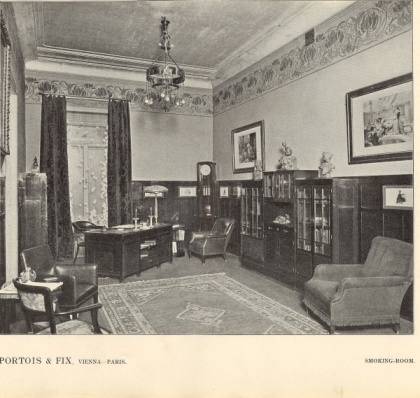
At the Winter Exhibition of the Österreichisches Museum für Kunst und Industrie (Austrian Museum for Art and Industry, today’s MAK) in 1906/07, Portois & Fix presented an apartment fully furnished with their own designs in the Columned Main Hall to demonstrate “that it was possible to create a tasteful, comfortable home also with relatively modest resources” (Catalogue of the Winter Exhibition at the Österreichisches Museum für Kunst und Industrie, 1906/07).
Due to the company’s presence and successful participation in the major exhibitions of the time, sales developed enormously, leading to the export of furniture to many foreign countries. In 1906, Portois & Fix had 700 employees and representations in London, Berlin, Wrocław, Cologne, Milano, Torino, Karlovy Vary, Paris, Budapest, Bombay, Cairo and Constantinople.
„Die in Rede stehende Firma gehört unstreitig zu den ersten ihrer Branche überhaupt und genießt tatsächlich einen Weltruf. Ihr Export ist ein außerordentlich bedeutender, und das Ansehen, dessen sich das österreichische Kunstgewerbe gegen-wärtig im gesamten Auslande erfreut, kann zum großen Teile dem Verdienste der Firma Portois & Fix zugeschrieben werden. Die Fabrik ist auf das beste und modernste eingerichtet und bildet mit dem Warenhause eine Sehenswürdigkeit Wiens.“ (1907)
Selected literature:
Vera J. Behal, Möbel des Jugendstils: Sammlung des Österreichischen Museums für Angewandte Kunst, München: Prestel Verlag, 1981, S. 65-66, 227-231.
Ausstellungskatalog: Ingrid Haslinger, Kunde: Kaiser, die Geschichte der ehemaligen k. u. k. Hoflieferanten, Wien 1996, S. 88, 89.
Certificate Card, Ausstellungskatalog Wien 2006, S. 15-19.
Ausstellungskatalog Pariser Esprit und Wiener Moderne. Die Firma Portois & Fix. ; Monika Wenzl-Bachmayer (Hrsg.), Wagner-Werk, Museum Postsparkasse, Wien 2008.














